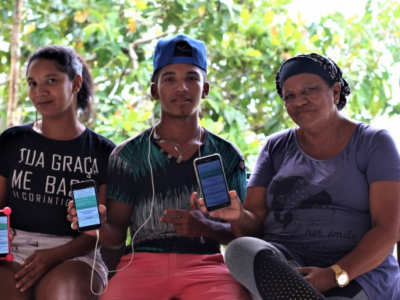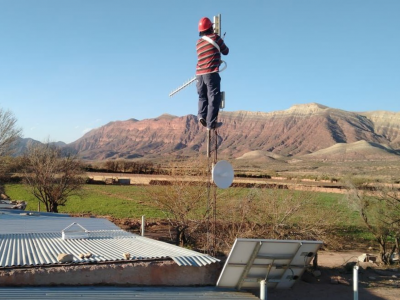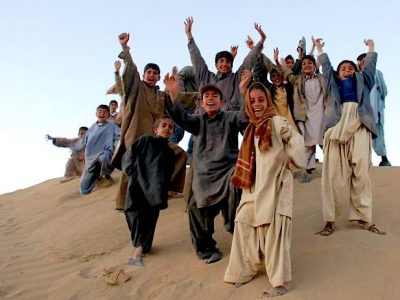
Photo provided by Internet Education and Research Laboratory (intERLab), Asian Institute of Technology, and Net2Home and used with permission.
Rising Voices (RV) is partnering with the Association for Progressive Communications (APC) which produced the 2018 Global Information Society Watch (GISWatch) focusing on community networks defined as “communication networks built, owned, operated, and used by citizens in a participatory and open manner.” Over the next several months, RV will be republishing versions of the country reports highlighting diverse community networks from around the world.
This country report was written by Kanchana Kanchanasut, Adisorn Lertsinsrubtavee, Apinun Tunpan, Nisarat Tansakul, Preechai Mekbungwan, Nunthaphat Weshsuwannarugs, Parkpoom Tripatana of Internet Education and Research Laboratory (intERLab) – Asian Institute of Technology (AIT), Net2Home Social Enterprise. Please visit the GISWatch website for the full report which is also available under a CC BY 4.0 license.
Providing connectivity to rural communities has been one of the most challenging tasks worldwide, and Thailand is no exception. In this country, fibre optic connectivity to homes is still confined to provincial capitals and big towns. Although cellular coverage is extensive, data packages are expensive. More recently, fibre optic networks have been pushed by the government under the One Access Per Village Project, with 24,700 villages connected to the internet by the end of 2017 with one fibre end per village. But to access the net, villagers have to gather around the dropping points similar to those telecentre projects in the early days.
TakNet is one of the most successful community network projects in Thailand, bringing significant impact and improvement to people’s lives in the province of Tak in the northwest of Thailand since 2013. Currently 15 communities have set up networks in their villages, with more than 1,000 residents using community networks on a daily basis. TakNet remains an experimental project that aims to provide internet connectivity to rural homes at affordable rates and acceptable quality. This makes it different from the telecentre approach. It was also planned for community members to be jointly responsible for the network.
At the time of writing, TakNet is the only community network operating in Thailand. This report discusses key success factors in setting up the network in response to a lack of connectivity at the local level.
Regulatory environment
Even though there is no specific policy in favour of running community networks in Thailand, local regulations allow us to use unlicensed 2.4 and 5 GHz bands in which the transmission range is limited. Nevertheless, this means less freedom to choose other wireless frequencies that many overseas community networks have. The frequency restriction limits our network size and coverage. The use of sub-1 GHz frequency bands such as TV white space (TVWS) is not allowed in our country. The Thai regulator, the National Broadcasting and Telecommunications Commission, is reluctant to ease regulations such as using high transmission for point-to-point communication and deploying rural broadband via TVWS. It is our policy to abide by existing rules and regulations in our network design and operation, limiting ourselves to the technology choices that are permissible. We are currently operating with an internet service provider (ISP) licence that has been issued to our Net2Home social enterprise company (see below).
Network set-up
The idea behind TakNet originated from our earlier work in post-disaster communication networks using mobile network technology. We realised that familiarity with technology is vital for successful deployment under stressful post-disaster scenarios; our work on community networks was built on this experience.
In general, a community network is a form of self-configuring and “self-healing” network where routers use dynamic routing protocols to form an ad hoc network. A community network allows individual users to join the network and share the connectivity by setting up their own relay routers at a village level up to city scale.
Initially, TakNet was a technical experiment connecting villagers using wireless mesh networks which could be easily transformed to become an emergency communication network in times of natural disasters. Now we use small mobile routers with firmware called DUMBO, designed for post-disaster communication, to connect houses together using a limited 3G/ADSL gateway to the internet. The DUMBO firmware includes the Optimized Link State Routing (OLSR) protocol to form the mesh network, SIP phones and a few other applications like short message applications that users can deploy. The simplicity of DUMBO firmware enables the community to build or extend the TakNet network in an ad hoc manner to meet their own needs. This means that in case of natural disasters they would be able to repurpose their routers, currently fixed to their walls, to form a post-disaster communication network almost immediately.
Key success factors of TakNet
The key success factor of our project is its strong collaboration between three main players: the research and development team led by the Internet Education and Research Laboratory (intERLab) of the Asian Institute of Technology, who develop and apply the DUMBO firmware for the community network; the corporate social responsibility (CSR) programme of the Thai Network Information Center Foundation (THNICF); and the local community’s participation. In addition, as mentioned, our Net2Home social enterprise licence allows us to function as an ISP.
The intERLab team plays the key role in terms of software development by customising the DUMBO firmware to form the wireless mesh network. The intERLab team also concentrates on research and development to improve the network infrastructure using new technologies (e.g. TVWS, LTE small cell) as well as proposing new services for TakNet such as VoIP, instant messaging, video-on-demand and distributed ledger (or shared database) to support the day-to-day activities of community members. While doing research and development for TakNet, intERLab uses TakNet as its research test bed for other research projects, such as using the internet of things (IoT) for monitoring air quality.
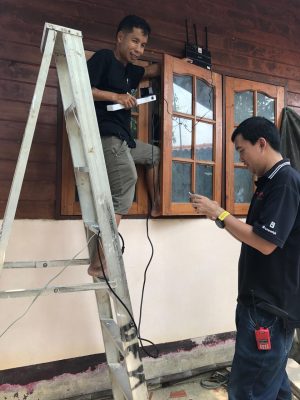
Photo provided by Internet Education and Research Laboratory (intERLab), Asian Institute of Technology, and Net2Home and used with permission.
After five years, with our limited resources, we have expanded to 15 communities and have over 1,000 users. We are introducing different wireless technologies so that we can connect hard-to-reach areas.
A few years after our first community network village was connected, ISPs started to move in and offered services to the village. We viewed this as a positive benefit to the community – they would have better internet access and more choices. We worked with ISPs in reaching out to those villagers that could not afford the ISP’s standard service price.
Today, despite the government's fibre-to-village project, and the penetration of the networks by the big ISPs, access is still quite limited. If the villagers opt for the government network, they have to visit a telecentre or go to other places where fibre optic lines get dropped. This can be quite far from their homes and cause concerns for parents. If the villagers opt for a commercial ISP, the monthly fees are still unaffordable for most of them. While last-mile fibre infrastructures are now receiving attention from the government, the regulator and big ISPs, we are convinced that the last metres in remote villages can be served very well by community networks.
Pathway to sustainability
Initially, we relied on young volunteers who were university students or new graduates attending the annual Thailand Networking Group (THNG) Camp supported by the THNICF to help us with field deployments. These young volunteers went out to visit rural villagers and convinced them to get routers installed on the external walls of their homes. This provides a good start for building a reliable and resilient community network. DUMBO routers and other equipment were donated by various cooperates through the THNG Camp and other THNICF fundraising activities. After the network set-up was completed, the intERLab team and the THNG Camp members trained the villagers in how to use our networks. When the villagers started to use our network, we asked for village volunteers to act as the local technical support team. Then our researchers taught the technicians how to maintain the network. It was not successful in the beginning. We had to persevere and teach them slowly. Now they know how to maintain, expand and deploy new sites.
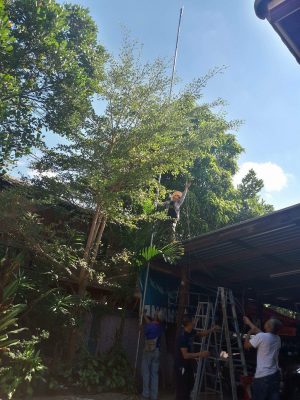
Photo provided by Internet Education and Research Laboratory (intERLab), Asian Institute of Technology, and Net2Home and used with permission.
To implement this plan, we started a social enterprise called Net2Home in 2016 to fully manage the services and network deployment of TakNet. In this new model, the monthly fee for each participant is increased to USD 8 per month to cover the cost of network equipment installation, maintenance, internet connectivity and the use of local services (e.g. distributed ledger application, VoIP, video streaming, chat applications). However, this new subscription fee is still three times cheaper than those of the commercial ISP. After operating TakNet under the Net2Home company, the number of deployments increased from one to five communities per year.
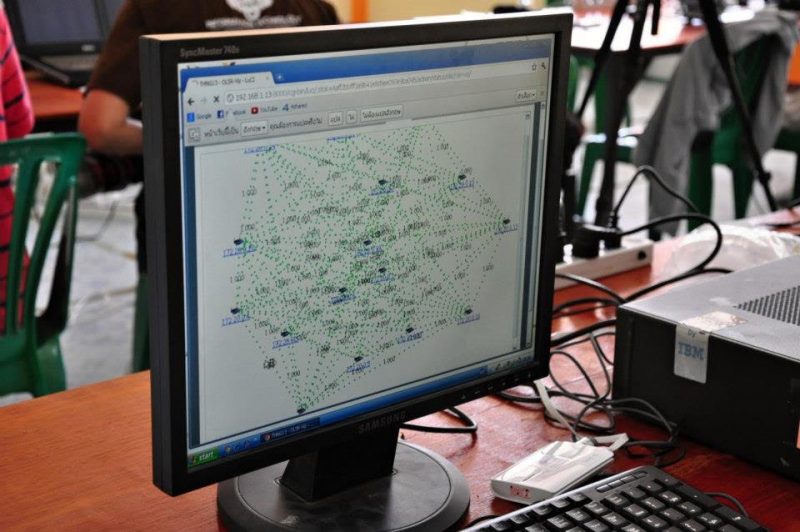
Photo provided by Internet Education and Research Laboratory (intERLab), Asian Institute of Technology, and Net2Home and used with permission.
We believe that a community network offers more value to members than just a connection to the internet. As mentioned, to ensure economic sustainability, TakNet aims to attract more members by introducing incentive applications like distributed ledger and chat applications. And with the IoT, community networks can be extended to provide services to agriculture and local village manufacturing activities, as well as offering waste or pollution management solutions inside a community. These economic and health value-added services could be very helpful in making the community network more sustainable.
Women at TakNet
TakNet provides local, national and international opportunities for women in a variety of activities, such as software/hardware development, network deployment in several rural villages in the province of Tak, and the chance to present scientific research at international conferences. At present, almost 50% of our team members at intERLab and Net2Home are women, while at the community level we also found that most of the community leaders working with us are women.
Conclusions
Internet subscriptions in Thailand are rather expensive even for urban residents with average wages higher than those in rural areas. The digital divide is a common social issue. While our experience may not impact on internet access for extremely remote villages, a digital divide still exists in villages with just one or two links to the internet, and we helped expand these one or two drop points to cover all houses within the village.
From our five years’ experience, we have faced several challenges that have required concrete solutions to support the network’s growth and long-term sustainability. Specifically, it will be very important to incorporate a broader, ambitious vision with core values when designing the next developmental phases of our rural community wireless mesh networks. Key issues like enabling faster digital transformation, improving agriculture yields, creating cleaner and greener manufacturing systems, and providing tighter socioeconomic integration of rural communities can serve as some important goals and milestones. To realise our vision, we need to re-think and prioritise from the perspective of villagers’ painful experiences, to create solutions to tackle the issues they face, and to implement a business model that is integrated into these solutions. Modern developmental approaches such as the “lean and agile” methodology could prove to be highly valuable. We believe that technological innovations come through research, observation, participation and collaboration. Because of this, activities and funding in relevant research areas should be made available and managed effectively.
For more information regarding action steps for Thailand, please visit the full report on the GISWatch website.

